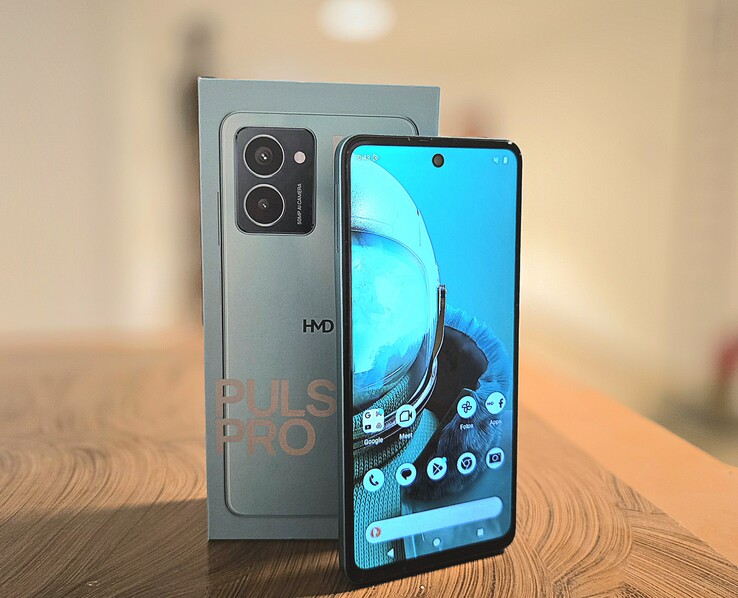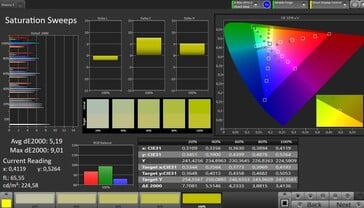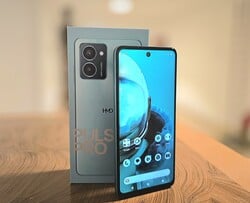HMD Pulse Pro 智能手机评测--经济实惠、可修复且极具特色?
潜在的竞争对手比较
Bewertung | Datum | Modell | Gewicht | Laufwerk | Groesse | Aufloesung | Preis ab |
|---|---|---|---|---|---|---|---|
| 77 % v7 (old) | 05 / 2024 | HMD Pulse Pro T7200 (T606), Mali-G57 MP1 | 196 g | 128 GB UFS 2.2 Flash | 6.65" | 1612x720 | |
| 79 % v7 (old) | 04 / 2024 | Motorola Moto G24 Power Helio G85, Mali-G52 MP2 | 197 g | 256 GB eMMC 5.1 Flash | 6.56" | 1612x720 | |
| 80 % v7 (old) | 04 / 2024 | Samsung Galaxy A15 Helio G99, Mali-G57 MP2 | 200 g | 128 GB UFS 2.2 Flash | 6.50" | 2340x1080 | |
| 80.2 % v7 (old) | 02 / 2024 | Xiaomi Redmi Note 13 4G SD 685, Adreno 610 | 188.5 g | 128 GB UFS 2.2 Flash | 6.67" | 2400x1080 |
» Notebookcheck多媒体笔记本电脑Top 10排名
» Notebookcheck游戏笔记本电脑Top 10排名
» Notebookcheck低价办公/商务笔记本电脑Top 10排名
» Notebookcheck高端办公/商务笔记本电脑Top 10排名
» Notebookcheck工作站笔记本电脑Top 10排名
» Notebookcheck亚笔记本电脑Top 10排名
» Notebookcheck超级本产品Top 10排名
» Notebookcheck变形本产品Top 10排名
» Notebookcheck平板电脑Top 10排名
» Notebookcheck智能手机Top 10排名
» Notebookcheck评测过最出色的笔记本电脑屏幕
» Notebookcheck售价500欧元以下笔记本电脑Top 10排名
» Notebookcheck售价300欧元以下笔记本电脑Top 10排名
机箱和规格 - 设计精美的塑料机箱
智能手机市场上的新玩家总是有些特别,但这里所说的制造商其实是一位知名人物:HMD 从 2016 年开始生产诺基亚手机,旨在为经济型手机市场带来可修复性和可持续性。
HMD Pulse Pro 是以该公司实际名称推出的首批设备之一--今后不会再有新的诺基亚手机。作为开端,制造商发布了一款售价约 180 欧元(190 美元)的智能手机,采用塑料机身,有三种配色:该手机采用塑料机身,有三种配色:黑海洋、暮光紫和冰川绿。我们这次评测的是一款绿色机型。
这三种颜色的机身背面都采用了光面设计,可多层反射光线,营造出非常时尚的效果。但使用数小时后,指纹可能会显现出来。
相机模块位于机身后部左上角,略微突出机身。它与机身的贴合非常整齐,倒角边缘和深色材质看起来非常时尚。机身的坚固程度可以接受:设备在受到一定的力时可以弯曲,但不会发出嘎吱嘎吱的响声。即使是轻微的压力也会影响显示屏中的液晶。
正面有一个相对较大的自拍摄像头冲孔,下巴有些突出。尽管如此,这款手机的设计在同价位手机中还是相当现代的。
HMD 非常重视手机的可修复性。通过与iFixitiFixit 合作,以合理的价格提供备件(目前更换屏幕和修复套件的价格为 45 欧元或 45 美元)。相应的指南也可以在网站上找到。HMD 在一份新闻稿中将此称为 "第一代可修复性",暗示未来的设备可以提供更好的可修复性。
Pulse Pro 拥有 128 GB 高速 UFS 存储空间和 6 GB 内存。它同样支持 NFC,可用于移动支付服务和扫描标签。你可以通过 3.5 毫米音频接口连接一副耳机,USB-C 端口支持充电和数据传输。
HMD Pulse Pro 提供两个 SIM 卡插槽,但使用 microSD 卡扩展存储需要放弃其中一个插槽。在我们使用 Angelbird V60 参考 microSD 卡进行的测试中,读卡器的表现相当不错,提供了该级别手机的典型传输速率,并保持了相当稳定的性能。
| SD Card Reader - average JPG Copy Test (av. of 3 runs) | |
| Samsung Galaxy A15 (Angelbird V60) | |
| HMD Pulse Pro (Angelbird V60) | |
| Motorola Moto G24 Power (Angelbird V60) | |
| Average of class Smartphone (7.7 - 77, n=73, last 2 years) | |
| Xiaomi Redmi Note 13 4G (Angelbird V60) | |
Cross Platform Disk Test (CPDT)
连接、软件和操作 - 完整的更新承诺
HMD Pulse Pro 最高支持 Wi-Fi 5,这意味着它的数据传输速率在 300 到 350 Mbit/s 之间。虽然我们在测试中看到了轻微的波动,但传输速度总体上还是相当稳定的。
遗憾的是,这款新的 HMD 手机不支持 5G。该设备也只兼容有限的 4G 频率。因此,虽然 Pulse Pro 可以在欧洲中部使用,但如果您计划去更远的地方旅行,则需要提前检查它是否能够访问目的地国家的 4G 网络。我们在城市环境中的随机地点进行了测试,发现接收质量很稳定,但不如高端手机。
这款手机搭载的是Android 14,但 HMD 在数字排毒方面做了一些改动。例如,预装应用程序的图标采用了黑白两色,随机附带的铃声也尽可能让人平静。专家们将在这方面继续努力,为用户提供更轻松的体验,帮助他们偶尔放下手机。
制造商承诺会提供两次操作系统更新(即更新至Android 16),这对于这个价位的手机来说绝非易事。安全更新也将每季度提供一次,至少持续到 2027 年 5 月。在本次评测时,安全补丁的日期是 2024 年 2 月,这意味着下一次更新应该就在眼前。
显示屏能以 90Hz 的频率运行,因此能迅速可靠地响应我们的输入。触摸屏即使在边缘和角落也能正常工作。设备右侧内置了快速、准确的指纹传感器。Pulse Pro 还提供面部解锁功能,但显示屏发出的光线有时不足以使该功能正常工作。
| Networking | |
| HMD Pulse Pro | |
| iperf3 transmit AXE11000 | |
| iperf3 receive AXE11000 | |
| Motorola Moto G24 Power | |
| iperf3 transmit AXE11000 | |
| iperf3 receive AXE11000 | |
| Samsung Galaxy A15 | |
| iperf3 transmit AXE11000 | |
| iperf3 receive AXE11000 | |
| Xiaomi Redmi Note 13 4G | |
| iperf3 transmit AXE11000 | |
| iperf3 receive AXE11000 | |
照相机 - 更多用于快照
HMD Pulse Pro 的摄像头像素很容易记住:主摄像头和自拍摄像头的分辨率均为 5000 万像素。后置摄像头两侧有第二个镜头,用于营造景深效果。不过,这个摄像头不能单独拍摄图像。
主摄像头拍摄的照片相当清晰,但对比度一般:在前景明亮、背景昏暗的情况下,一些细节会丢失。在我们周围环境的照片中,有些区域曝光过度,前景中的物体和大表面上的细节显得模糊不清。照片中的某些区域也同样显得模糊不清,缺乏对比度。主摄像头可以通过光源有效地提亮暗部图像,但这也会导致亮部细节丢失。整体看来,图像模糊且颗粒感较强。
在我们的实验室中,在全光照条件下,相机拍摄的图像色温较低。在红色背景的字母和数字周围偶尔会出现像素化边缘。但其他方面的图像质量还是令人满意的。在 1 勒克斯光照下拍摄的照片根本无法辨认出任何东西。
HMD Pulse Pro 可录制高达 1080p 和 30 fps 的视频。自动曝光相当迅速,但自动对焦明显滞后,而且并不总是非常准确。
HMD 非常重视 5000 万像素的自拍摄像头,它可以通过手势(如心形或和平手势)触发。我们的评测团队在使用这一非常方便的功能时获得了很多乐趣。遗憾的是,自拍照本身并没有给我们带来好心情。即使是第一眼看上去,照片也有些模糊,暗部几乎没有任何细节。照片放大后,细节也显得模糊不清。
Image Comparison
Choose a scene and navigate within the first image. One click changes the position on touchscreens. One click on the zoomed-in image opens the original in a new window. The first image shows the scaled photograph of the test device.
Main camera: plantMain camera: surroundingsMain camera: low light

显示屏 - Pulse Pro 的屏幕上没有 PWM
| |||||||||||||||||||||||||
Brightness Distribution: 89 %
Center on Battery: 501 cd/m²
Contrast: 2947:1 (Black: 0.17 cd/m²)
ΔE Color 5.21 | 0.5-29.43 Ø4.87
ΔE Greyscale 6.3 | 0.5-98 Ø5.1
96% sRGB (Calman 2D)
Gamma: 2.297
| HMD Pulse Pro IPS, 1612x720, 6.7" | Motorola Moto G24 Power IPS, 1612x720, 6.6" | Samsung Galaxy A15 Super AMOLED, 2340x1080, 6.5" | Xiaomi Redmi Note 13 4G AMOLED, 2400x1080, 6.7" | |
|---|---|---|---|---|
| Response Times | -10% | 94% | 94% | |
| Response Time Grey 50% / Grey 80% * | 35.7 ? | 39 ? -9% | 2 ? 94% | 2.2 ? 94% |
| Response Time Black / White * | 26.1 ? | 28.6 ? -10% | 1.7 ? 93% | 1.6 ? 94% |
| PWM Frequency | 187 | 389.2 | ||
| Screen | -25% | 48% | 70% | |
| Brightness middle | 501 | 499 0% | 731 46% | 940 88% |
| Brightness | 470 | 497 6% | 711 51% | 922 96% |
| Brightness Distribution | 89 | 93 4% | 93 4% | 96 8% |
| Black Level * | 0.17 | 0.49 -188% | ||
| Contrast | 2947 | 1018 -65% | ||
| Colorchecker dE 2000 * | 5.21 | 4.82 7% | 2.31 56% | 1.2 77% |
| Colorchecker dE 2000 max. * | 8.79 | 7.76 12% | 3.51 60% | 2.28 74% |
| Greyscale dE 2000 * | 6.3 | 4.7 25% | 1.7 73% | 1.4 78% |
| Gamma | 2.297 96% | 2.073 106% | 2.091 105% | 2.27 97% |
| CCT | 8524 76% | 7445 87% | 6424 101% | 6503 100% |
| Total Average (Program / Settings) | -18% /
-22% | 71% /
60% | 82% /
76% |
* ... smaller is better
Display Response Times
| ↔ Response Time Black to White | ||
|---|---|---|
| 26.1 ms ... rise ↗ and fall ↘ combined | ↗ 12.7 ms rise | |
| ↘ 13.4 ms fall | ||
| The screen shows relatively slow response rates in our tests and may be too slow for gamers. In comparison, all tested devices range from 0.1 (minimum) to 240 (maximum) ms. » 63 % of all devices are better. This means that the measured response time is worse than the average of all tested devices (20.8 ms). | ||
| ↔ Response Time 50% Grey to 80% Grey | ||
| 35.7 ms ... rise ↗ and fall ↘ combined | ↗ 18.8 ms rise | |
| ↘ 16.9 ms fall | ||
| The screen shows slow response rates in our tests and will be unsatisfactory for gamers. In comparison, all tested devices range from 0.165 (minimum) to 636 (maximum) ms. » 47 % of all devices are better. This means that the measured response time is similar to the average of all tested devices (32.5 ms). | ||
Screen Flickering / PWM (Pulse-Width Modulation)
| Screen flickering / PWM not detected | |||
In comparison: 53 % of all tested devices do not use PWM to dim the display. If PWM was detected, an average of 8516 (minimum: 5 - maximum: 343500) Hz was measured. | |||
性能、排放和电池寿命 - 需要更快的 SoC
HMD 选择了相当薄弱的 Unisoc T606系统芯片。即使在这个价格范围内,现在也有功能更强大的手机可供选择。在日常使用中,即使在运行基本应用程序或浏览菜单时,也会出现等待时间过长和卡顿的问题。
不过,HMD 在存储方面并没有偷工减料。Pulse Pro 使用 UFS 2.2,速度相当快,减少了传输和加载数据所需的时间。尽管系统芯片速度相对较慢,但这也有助于系统流畅运行。
我们在手机正面测得的最高温度为 43.9°C(111.0°F)。这一点非常明显,在温暖的日子里甚至可能会升高。3DMark 压力测试显示,SoC 的性能并未受到热量的影响。
HMD Pulse Pro 底部边缘是一个单声道扬声器,可提供不错的音效。它的音量可以通过 Audio Boost(音频增强)功能进一步增大,但这会使其听起来高音偏重。禁用该功能后,扬声器的声音会更加饱满,并能提供清晰的语音和人声。
您还可以通过 3.5 毫米音频插孔或蓝牙将外部音频设备连接到手机。在我们的测试中,这两种方法都能发出清晰的音频。Pulse Pro 提供多种无线音频编解码器可供选择:除了 SBC、AAC、aptX、aptX HD 和 LDAC 等标准编解码器外,还提供略微高级的 Opus 和 LC3。
Pulse Pro 的电池容量为 5,000 mAh,这在这个价位的大多数设备中很常见。在我们的电池续航时间对比中,这款手机的表现相当不错,在我们的 Wi-Fi 测试中几乎刚好可以使用 15 个小时。在频繁使用的情况下,它的续航能力足以支撑一整天。手机充电功率可达 20 瓦,但 HMD 没有提供充电器。
| HMD Pulse Pro | Motorola Moto G24 Power | Samsung Galaxy A15 | Xiaomi Redmi Note 13 4G | Average 128 GB UFS 2.2 Flash | Average of class Smartphone | |
|---|---|---|---|---|---|---|
| AndroBench 3-5 | -63% | -8% | -13% | -23% | 71% | |
| Sequential Read 256KB | 966 | 297 -69% | 967.8 0% | 909.8 -6% | 725 ? -25% | 2030 ? 110% |
| Sequential Write 256KB | 824 | 253.2 -69% | 488.5 -41% | 606.3 -26% | 523 ? -37% | 1646 ? 100% |
| Random Read 4KB | 205 | 100 -51% | 233.2 14% | 177.1 -14% | 191.9 ? -6% | 282 ? 38% |
| Random Write 4KB | 239 | 92.2 -61% | 229.6 -4% | 228 -5% | 184.1 ? -23% | 325 ? 36% |
温度
(±) The maximum temperature on the upper side is 43.9 °C / 111 F, compared to the average of 35.1 °C / 95 F, ranging from 21.9 to 63.7 °C for the class Smartphone.
(±) The bottom heats up to a maximum of 40.6 °C / 105 F, compared to the average of 33.9 °C / 93 F
(+) In idle usage, the average temperature for the upper side is 23 °C / 73 F, compared to the device average of 32.8 °C / 91 F.
3DMark Wild Life Stress Test
HMD Pulse Pro audio analysis
(±) | speaker loudness is average but good (79.9 dB)
Bass 100 - 315 Hz
(-) | nearly no bass - on average 30.2% lower than median
(±) | linearity of bass is average (7.7% delta to prev. frequency)
Mids 400 - 2000 Hz
(±) | higher mids - on average 8.7% higher than median
(±) | linearity of mids is average (9.8% delta to prev. frequency)
Highs 2 - 16 kHz
(±) | higher highs - on average 5.6% higher than median
(+) | highs are linear (6.9% delta to prev. frequency)
Overall 100 - 16.000 Hz
(-) | overall sound is not linear (30.5% difference to median)
Compared to same class
» 77% of all tested devices in this class were better, 4% similar, 19% worse
» The best had a delta of 12%, average was 36%, worst was 134%
Compared to all devices tested
» 88% of all tested devices were better, 3% similar, 9% worse
» The best had a delta of 4%, average was 24%, worst was 134%
Xiaomi Redmi Note 13 4G audio analysis
(±) | speaker loudness is average but good (76.2 dB)
Bass 100 - 315 Hz
(-) | nearly no bass - on average 23.1% lower than median
(±) | linearity of bass is average (8% delta to prev. frequency)
Mids 400 - 2000 Hz
(±) | higher mids - on average 6.2% higher than median
(±) | linearity of mids is average (7.3% delta to prev. frequency)
Highs 2 - 16 kHz
(±) | higher highs - on average 5.2% higher than median
(±) | linearity of highs is average (10.9% delta to prev. frequency)
Overall 100 - 16.000 Hz
(±) | linearity of overall sound is average (22.5% difference to median)
Compared to same class
» 45% of all tested devices in this class were better, 7% similar, 48% worse
» The best had a delta of 12%, average was 36%, worst was 134%
Compared to all devices tested
» 63% of all tested devices were better, 6% similar, 31% worse
» The best had a delta of 4%, average was 24%, worst was 134%
| Battery Runtime - WiFi Websurfing | |
| Motorola Moto G24 Power | |
| Average of class Smartphone (476 - 3244, n=206, last 2 years) | |
| HMD Pulse Pro | |
| Samsung Galaxy A15 | |
| Xiaomi Redmi Note 13 4G | |
Pros
Cons
结论 - 一个不错的开端
凭借 Pulse Pro,HMD 创造了一款值得称赞的智能手机,这也是他们首次推出自己的品牌。这款手机在 200 欧元以下的机型中具有一些独特的功能,如相对较高的可修复性(备件价格低廉)、三年以上的更新和快速存储。
制造商赋予了机身时尚的设计,但如果能再坚固一些就更好了。扬声器音质尚可,电池续航时间相当长,显示屏相当明亮,没有使用 PWM。不过,这款手机的性能尤其没有给人留下深刻印象;在这个价位的手机中,有速度更快的替代品。
主摄像头有点令人失望,即使对于一款经济型手机来说也是如此。号称 5000 万像素的前置摄像头也只能拍出不太吸引人的自拍照。
HMD 想做的事情很多,未来有可能成为令人瞩目的替代产品。但该制造商在 HMD Pulse Pro 上的做法仍然非常稳妥,以适中的价格提供了一款具有良好维修性和长期更新支持的可靠智能手机。
HMD Pulse Pro 是一款外观漂亮、维修相对容易的经济型手机。
如果您想选择其他手机,可以考虑 三星Galaxy A15 4G或 小米Redmi Note 13 4G.这两款设备性能更强,采用 AMOLED 屏幕,但不便于用户更换,而且更新承诺有限。
HMD Pulse Pro
- 05/02/2024 v7 (old)
Florian Schmitt
Transparency
The selection of devices to be reviewed is made by our editorial team. The test sample was provided to the author as a loan by the manufacturer or retailer for the purpose of this review. The lender had no influence on this review, nor did the manufacturer receive a copy of this review before publication. There was no obligation to publish this review. We never accept compensation or payment in return for our reviews. As an independent media company, Notebookcheck is not subjected to the authority of manufacturers, retailers or publishers.
This is how Notebookcheck is testing
Every year, Notebookcheck independently reviews hundreds of laptops and smartphones using standardized procedures to ensure that all results are comparable. We have continuously developed our test methods for around 20 years and set industry standards in the process. In our test labs, high-quality measuring equipment is utilized by experienced technicians and editors. These tests involve a multi-stage validation process. Our complex rating system is based on hundreds of well-founded measurements and benchmarks, which maintains objectivity. Further information on our test methods can be found here.





































